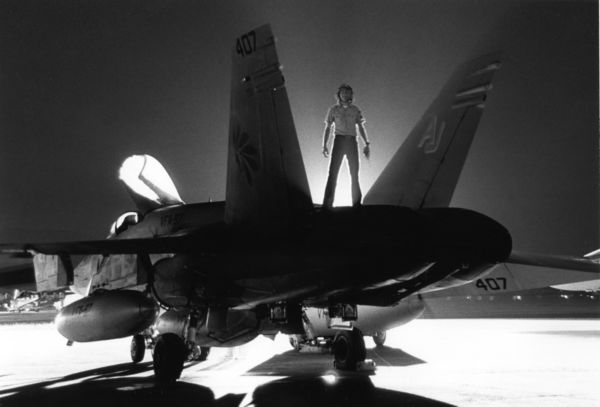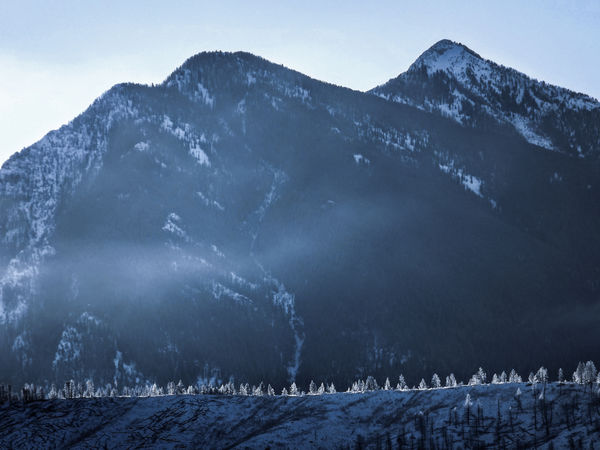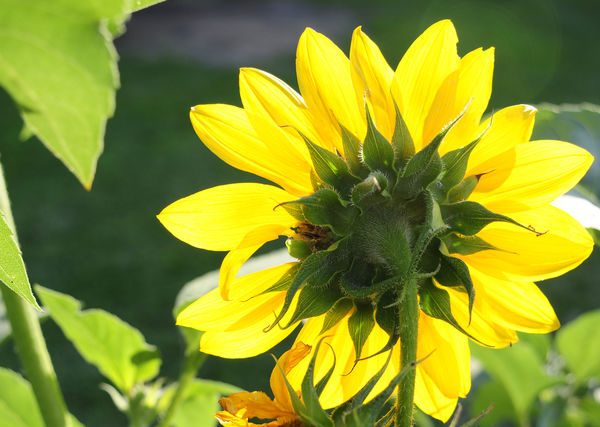Considering the Aspects of Light: Part 1 - Direction
May 19, 2018 11:28:31 #
Linda From Maine wrote:
.....is it too obvious... to suggest that with any subject we enjoy photographing..... how you use the direction of light is a huge component of the image's success?
One of the insights that I'll take away from this discussion is that as a subject, light is proving to be resilient to any generalisations and rules. That is mainly due to the fact that the appropriateness (or otherwise) of different kinds of light is totally subject-dependent, and in addition to that, the setting can be a very significant factor. We've had Richard saying that directionless light is best for his subject (motorsport) and at the same time every other possibility has been shown favour by someone, where the preference is totally dependent on the subject/setting.
In the absence of any clear-cut rules - or even generalisations - what can we take away from a thread like this? To my mind it's obvious that we have to develop our eye for light and what works and what doesn't, because it changes with each subject and setting. That may seem blindingly obvious, but it would be a mistake to try to find universal DOs and DON'Ts and then try to apply them as part of our workflow.
None of this takes away from the fact that the thread has a generous sprinkling of helpful insights throughout, and that's what we're all hoping to find. But what I've noticed is that these insights are all very subject-related. Universal rules and generalisations are wonderful when they're appropriate, but potentially very un-constructive, anti-creative and limiting when they're not appropriate.
May 19, 2018 11:46:59 #
We have the luxury of stereoscopic vision to give depth to anything we view. We lose this when the view is translated to 2D as in a photograph. This is partly the reason for the number of disappointing snaps taken of grand views on a sunny day. In fact, almost all of our senses contribute to our enjoyment of a landscape, it's called "being there". The only way, we the photographer, can evoke a sense of 3D, and thereby "being there" is by utilising light and shade created by directional lighting. We can use it in the same way that a theatre scenery painter uses trompe l'oeil to create a 3D effect on scenery flats, that is by using shadows mid-tones and highlights.
May 19, 2018 12:01:46 #
Linda From Maine wrote:
What I immediately thought in viewing this image i... (show quote)
Linda, I used some dodging and burning to help accentuate the shadows and the brighter regions of the landscape. This increases the sculptural feel to the scene.
May 19, 2018 14:33:58 #
Graham Smith wrote:
Concise, articulate, terrific Graham!We have the luxury of stereoscopic vision to give ... (show quote)
May 19, 2018 14:50:59 #
R.G. wrote:
One of the insights that I'll take away from this ... (show quote)
I seldom use the term "rules" in photography in that some might misconstrue the term as meaning instructions, laws or regulations that should not be questioned, altered, modified or broken. Of course, scientifically speaking, there are certain physical theories and mathematical formulas, pertaining to the behavior and components of light, that do remain fixed and definite.
Understanding and mastering certain principles and techniques should not be counterproductive or antithetical to creativity and in fact, the familiarity with the technicalities should facilitate creativeness and artistry. Oftentimes, it takes a fair bit of doing to land an image on the film or sensor as we perceive it or wish to alter or interpret it. When we know exactly what we are doing, dealing with the technicalities become second nature, almost autonomic and the photographer can concentrate on the aesthetics, the expressions and the elements that go far beyond the practical.
Folks who fully comprehend the principles, know best how to preserve, manipulate, fracture or even abandon them when the occasion arises and yet when there are technical difficulties they can rise to the occasion and come out with the image they wish to achieve.
Also- When teaching, inspiring others and sharing information and know-how, one needs to present some guide lines, nomenclature and certain axiomatic principles. It's easy enough to just tell someone to go out and appreciate the light- see the light but oftentimes the eyes and the mind require some form of training and enlightenment. To me it's like a person studying music. An individual may be born with perfect pitch, a sense of rhythm and lots of potential talent but they still usually need to study "ear training", sight reading, harmony and theory to perfect their performance.
This particular thread was not intended as a technical tutorial, however, a certain mastery of the science is nonetheless important in creating artful, emotional and storytelling imagery.
May 19, 2018 20:06:52 #
Linda sent me the link to this thread a few days ago. Thank you Linda!
I don't really have much to add other than to say thanks to those who did a very nice job of showing, and or explaining an important aspect of light in our photos.
--
I don't really have much to add other than to say thanks to those who did a very nice job of showing, and or explaining an important aspect of light in our photos.
--
May 19, 2018 22:34:46 #
A photo that I captured in my pre-DSLR days was this back yard photo of a ridge-top tree line, To better visualize the setting you must place another large mountain to the left and slightly nearer the tree line, to the immediate left is a canyon. The sun is shining from the left, through the canyon and onto the ridge top, the tree line and the wisp of cloud. The canyon is a natural Stonehenge so this particular sunlight alignment happens only a couple times a year. On this occasion the trees were loaded with rime ice which created the aura. I noticed the metadata indicating time of 10:20 am, January 2014. Sunrise that time of year is probably just about 8am but the sun has a little more elevation to gain before peeking over the 10,000 foot peaks just east of the house. Plenty of time for morning coffee and UHH.
Thank you, Linda, for the notice about this subject and to all those who have contributed in making my afternoon in study of the direction of light so enjoyable.
Thank you, Linda, for the notice about this subject and to all those who have contributed in making my afternoon in study of the direction of light so enjoyable.
May 20, 2018 07:23:16 #
E.L.. Shapiro wrote:
Your continuing interest in the thread, and your instruction are greatly appreciated, Ed!... a certain mastery of the science is nonetheless important in creating artful, emotional and storytelling imagery.
Bill_de wrote:
So glad you enjoyed, Bill! Thanks for stopping by ... thanks to those who did a very nice job of showing, and or explaining an important aspect of light in our photos.--

guardineer wrote:
What a cool photo! The download is fascination for the details and light and to know of the rarity of the occurance. Is this in Montana?... On this occasion the trees were loaded with rime ice which created the aura. I noticed the metadata indicating time of 10:20 am, January 2014...
Very glad you are enjoying the thread, and appreciate your contribution!
May 20, 2018 07:27:49 #
NOTICE
I'll be posting Chapter 2 on Tuesday morning. Please watch FYC's home page or if you use "newest topics" to browse UHH, be sure you're subscribed to this section. If you only use the daily digest, you might miss the topic
We'll explore the qualities of harsh and soft light - with properties such as intensity, contrast, diffused, fill flash and more.
Hope to see you!
I'll be posting Chapter 2 on Tuesday morning. Please watch FYC's home page or if you use "newest topics" to browse UHH, be sure you're subscribed to this section. If you only use the daily digest, you might miss the topic

We'll explore the qualities of harsh and soft light - with properties such as intensity, contrast, diffused, fill flash and more.
Hope to see you!
May 20, 2018 08:31:17 #
Linda From Maine wrote:
What a cool photo! The download is fascination for the details and light and to know of the rarity of the occurance. Is this in Montana?
Very glad you are enjoying the thread, and appreciate your contribution!
Very glad you are enjoying the thread, and appreciate your contribution!
Yes, Paradise valley, MT. It's my view beyond the back yard and is known as the Beartooth Absoraka Wilderness.
May 22, 2018 12:19:43 #
Linda:
Over the years that I have taught photography I would confess to my students lighting is something you will
never completely master. The reason that is so is due to your discovery and awareness of how light beings
new ways of previsualizing your photography. The movie "The Third Man" with Orson Welles is one example
of how great the golden age of cinema used lighting. Another was "Brief Encounter" where the opening scene
of an express train roaring past the station gives you some idea of how lighting is such a key part of conveying
an emotion to the viewer. The world of studio lighting using a cookaloris to suggest shadows is part of the art
of lighting. If you happen to be a beginner in photography I would recommend studying lighting in all its forms.
Scrims of diffusion material, gels. snoots and barn doors are a few of the terms you should be familiar with.
Once immersed in studying lighting you will think of it like eating just one potato chip....you have to have more.
Over the years that I have taught photography I would confess to my students lighting is something you will
never completely master. The reason that is so is due to your discovery and awareness of how light beings
new ways of previsualizing your photography. The movie "The Third Man" with Orson Welles is one example
of how great the golden age of cinema used lighting. Another was "Brief Encounter" where the opening scene
of an express train roaring past the station gives you some idea of how lighting is such a key part of conveying
an emotion to the viewer. The world of studio lighting using a cookaloris to suggest shadows is part of the art
of lighting. If you happen to be a beginner in photography I would recommend studying lighting in all its forms.
Scrims of diffusion material, gels. snoots and barn doors are a few of the terms you should be familiar with.
Once immersed in studying lighting you will think of it like eating just one potato chip....you have to have more.

May 22, 2018 12:55:20 #
Pixelmaster wrote:
Linda: br br Over the years that I have taught ph... (show quote)
Thank you so much for your inspiring insights, photo and suggestions to study films. Super-duper stuff!
Part 2 of our discussion series started this morning, if you'd like to join us:
http://www.uglyhedgehog.com/t-531762-1.html
Cookaloris:
https://en.wikipedia.org/wiki/Cucoloris
Greatly appreciate your comments!
May 31, 2019 15:51:05 #
Kaib795
Loc: Maryland, USA
Cwilson341 wrote:
Other than side lighting, probably my favorite would be back lighting. Because flowers and butterflies both tend to be translucent, they make excellent subjects for back lighting. Back lighting brings out colors and gives subjects a light and airy feel. Back lighting can also be very effective in creating silhouettes.
Ironically I've shot the same sunflower in a back lit view. I remember being out with my daughter showing her to look at different angles and in front and from the back ... and there was the shot ... into the sun! Yes, it's all about light.
If you want to reply, then register here. Registration is free and your account is created instantly, so you can post right away.


 ) to suggest that with any subject we enjoy photographing - flowers, street scenes, still life, landscape and other nature subjects, birds and critters, people or "stuff" both indoors and out - how you use the direction of light is a huge component of the image's success?
) to suggest that with any subject we enjoy photographing - flowers, street scenes, still life, landscape and other nature subjects, birds and critters, people or "stuff" both indoors and out - how you use the direction of light is a huge component of the image's success?



